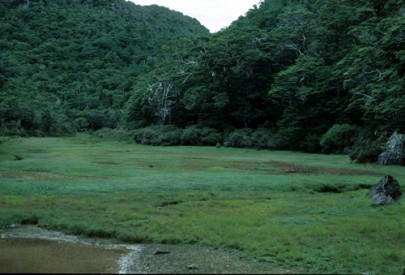Ephemeral wetlands
In this section

An ephemeral wetland in Burgoo Stream, western Nelson (Peter Williams)
Ephemeral wetlands are formed in closed depressions lacking a surface outlet and are wet only seasonally or in wet years. The water source is groundwater or an adjacent water body (Johnson & Rogers 2003). Substrates are usually mineral and they occur on a range of landforms including fluvial systems, bedrock, dunes, and volcanic deposits. Characteristic species include sneezeweed (Centipeda minima subsp. minima), Tarawera (Epilobium pallidiflorum), Glossostigma elatinoides, common water milfoil (Myriophyllum propinquum), Waoriki (Ranunculus amphitrichus), Sinclair’s sedge (Carex sinclairii), sharp spike sedge (Eleocharis acuta), Isolepis prolifer, I. sepulcralis, and I. setacea (Ogle 1994).
The subsets of ephemeral wetlands that occur on lake margins, dune deflation hollows, dune slacks and damp sand plains are described separately.
Synonyms
Notable flora and fauna
Threatened and rare plants include the extinct Logania depressa; the nationally critical Acaena rorida, sneezeweed (Centipeda minima subsp. minima), Crassula multicaulis, Crassula peduncularis, Deyeuxia lacustris, Lobelia fugax, New Zealand mousetail (Myosurus minimus subsp. novae-zelandiae), stalked adder’s tongue fern (Ophioglossum petiolatum), mountain myrrh (Oreomyrrhis colensoi var. delicatula), creeping foxglove (Ourisia modesta), Pimelea actea, kettlehole cudweed (Pseudognaphalium ephemerum), Sebaea ovata and marsh arrow grass (Triglochin palustris); the nationally endangered water brome (Amphibromus fluitans), sedge (Carex uncifolia), Coprosma talbrockiei, Gunnera densiflora, pygmy clubrush (Isolepis basilaris), Lobelia carens, Matthew’s forget-me-not (Myosotis matthewsii), and bastard grass (Uncinia strictissima). Nationally vulnerable species include the curly sedge (Carex cirrhosa), pygmy sundew (Drosera pygmaea), Gratiola concinna, hydatella (Hydatella inconspicua), Iphigenia novae-zelandiae, Isolepis fluitans var. fluitans, New Zealand iris (Libertia peregrinans), dwarf musk (Mazus novaezeelandiae subsp. impolitus f. impolitus), and Lady’s tresses (Spiranthes novae-zelandiae). Declining species include the slender niggerhead (Carex tenuiculmis), tufted hair grass (Deschampsia cespitosa), sand spike sedge (Eleocharis neozelandica), dwarf woodrush (Luzula celata), dwarf musk (Mazus novaezeelandiae subsp. novaezeelandiae), Ranunculus brevis, Selliera rotundifolia, and Tetrachondra hamiltonii.
Brachyscome linearis, iti (Cardamine lacustris), Carex capillacea, Edgar’s sedge (Carex edgariae), Carex traversii, Centrolepis minima, Crassula mataikona, Crassula ruamahanga, Lepilaena bilocularis, sand musk (Mazus arenarius), Ranunculus maculatus, Ranunculus ranceorum, and Ranunculus ternatifolius are naturally uncommon.
Colonisers include Gratiola pedunculata. Data-deficient species include creeping cudweed (Euchiton ensifer), Polygonum plebeium, and swamp buttercup (Ranunculus macropus). Indeterminate species include the nationally critical Limosella (b) (CHR 515038; Manutahi), Craspedia (j) (CHR 516302; Lake Heron), Cardamine (b) (CHR 312947; ‘tarn’), and Craspedia (e) (CHR 514391; ‘tarn’), and the naturally uncommon Myosotis aff. pygmaea (CHR 244566; Volcanic Plateau).
Threatened and rare fauna include several species of mudfish, i.e. brown mudfish (Neochanna apoda ), Canterbury mudfish (Neochanna borrowsius), black mudfish (Neochanna diversus), and Northland mudfish (Neochanna heleios), which is known from only three ephemeral wetland sites on the Kerikeri volcanic plateau and is abundant only at the type locality.
We have no information on threatened invertebrates.
Threat status
Critically endangered (Holdaway et al. 2012)
Threats
Ephemeral wetlands are under threat of invasion by numerous exotic weeds, particularly nitrogen-fixers such as gorse (Ulex europaeus), conifers especially pines (Pinus spp.) and pasture weeds and grasses. Unfenced areas in agricultural settings are highly threatened by domestic and feral animals as they are a fragile system prone to trampling or browsing damage. Nutrient enrichment from fertiliser and stock is also a problem. There is evidence, however, that some level of grazing and compaction, by seabirds, seals, or mammalian herbivores, may be required to maintain these communities. There is some evidence that rare species decline when areas are managed for conservation by removing mammalian herbivores. Ephemeral wetlands are usually easily drained and converted to agriculture. Off-road vehicle disturbance can be an issue, particularly in dry seasons.
Where do they occur?
Ephemeral wetlands are localised, but scattered widely throughout New Zealand from the lowlands to the mountains.
Further reading
Cadwallader PL 1975. Distribution and ecology of the Canterbury mudfish, Neochanna borrowsius (Phillips) (Salmoniformes: Galaxiidae). Journal of the Royal Society of New Zealand 5:21-30.
Johnson P 2003. Canterbury kettles and other ephemeral wetlands: collection centres for native plant diversity. Canterbury Botanical Society 37:42-47.
Johnson PN, Rogers G 2003. Ephemeral wetlands and their turfs in New Zealand. Science for Conservation 230. Department of Conservation, Wellington. 109 p.
Johnson P, Gerbeaux P 2004. Wetland types in New Zealand. Wellington, Department of Conservation.
Ling N, Gleeson DM 2001. A new species of mudfish, Neochanna (Teleostei: Galaxiidae), from northern New Zealand. Journal of the Royal Society of New Zealand 32:385-392.
Ogle CC 1994. Recognition of ephemeral wetlands from their plant species assemblages. Science and Research Series 67. Wellington, Department of Conservation.
Rogers G, Walker S, Tubbs M, Henderson J 2002. Ecology and conservation status of three 'spring annual' herbs in dryland ecosystems of New Zealand. New Zealand Journal of Botany 40:649-669.
Tanentzap AJ, Lee WG, Monks A, Ladley K, Johnson PN, Rogers GM, Comrie JM, Clarke DA, Hayman E 2014. Identifying pathways for managing multiple disturbances to limit plant invasions. Journal of Applied Ecology 51: 1015–1023. doi: 10.1111/1365-2664.12271


